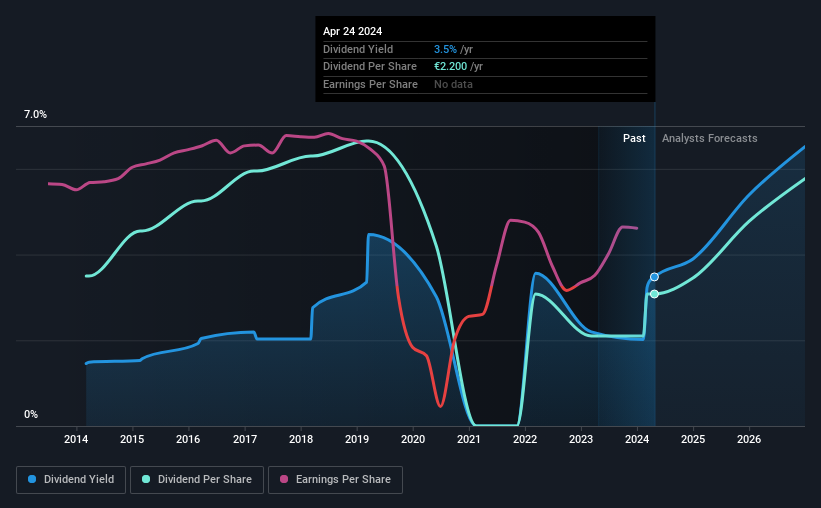Continental Aktiengesellschaft (ETR:CON) stock is about to trade ex-dividend in 3 days. The ex-dividend date is one business day before a company’s record date, which is the date on which the company determines which shareholders are entitled to receive a dividend. The ex-dividend date is an important date to be aware of as any purchase of the stock made on or after this date might mean a late settlement that doesn’t show on the record date. In other words, investors can purchase Continental’s shares before the 29th of April in order to be eligible for the dividend, which will be paid on the 2nd of May.
The company’s upcoming dividend is €2.20 a share, following on from the last 12 months, when the company distributed a total of €1.50 per share to shareholders. Based on the last year’s worth of payments, Continental has a trailing yield of 3.5% on the current stock price of €63.24. Dividends are a major contributor to investment returns for long term holders, but only if the dividend continues to be paid. As a result, readers should always check whether Continental has been able to grow its dividends, or if the dividend might be cut.
Check out our latest analysis for Continental
Dividends are usually paid out of company profits, so if a company pays out more than it earned then its dividend is usually at greater risk of being cut. Continental paid out a comfortable 38% of its profit last year. Yet cash flow is typically more important than profit for assessing dividend sustainability, so we should always check if the company generated enough cash to afford its dividend. It distributed 25% of its free cash flow as dividends, a comfortable payout level for most companies.
It’s encouraging to see that the dividend is covered by both profit and cash flow. This generally suggests the dividend is sustainable, as long as earnings don’t drop precipitously.
Click here to see the company’s payout ratio, plus analyst estimates of its future dividends.
Have Earnings And Dividends Been Growing?
Companies with falling earnings are riskier for dividend shareholders. If earnings decline and the company is forced to cut its dividend, investors could watch the value of their investment go up in smoke. Continental’s earnings per share have fallen at approximately 17% a year over the previous five years. Such a sharp decline casts doubt on the future sustainability of the dividend.
Another key way to measure a company’s dividend prospects is by measuring its historical rate of dividend growth. Continental has seen its dividend decline 1.3% per annum on average over the past 10 years, which is not great to see.
To Sum It Up
From a dividend perspective, should investors buy or avoid Continental? Earnings per share are down meaningfully, although at least the company is paying out a low and conservative percentage of both its earnings and cash flow. It’s definitely not great to see earnings falling, but at least there may be some buffer before the dividend needs to be cut. It might be worth researching if the company is reinvesting in growth projects that could grow earnings and dividends in the future, but for now we’re not all that optimistic on its dividend prospects.
With that in mind, a critical part of thorough stock research is being aware of any risks that stock currently faces. Every company has risks, and we’ve spotted 1 warning sign for Continental you should know about.
If you’re in the market for strong dividend payers, we recommend checking our selection of top dividend stocks.
Have feedback on this article? Concerned about the content? Get in touch with us directly. Alternatively, email editorial-team (at) simplywallst.com.
This article by Simply Wall St is general in nature. We provide commentary based on historical data and analyst forecasts only using an unbiased methodology and our articles are not intended to be financial advice. It does not constitute a recommendation to buy or sell any stock, and does not take account of your objectives, or your financial situation. We aim to bring you long-term focused analysis driven by fundamental data. Note that our analysis may not factor in the latest price-sensitive company announcements or qualitative material. Simply Wall St has no position in any stocks mentioned.
